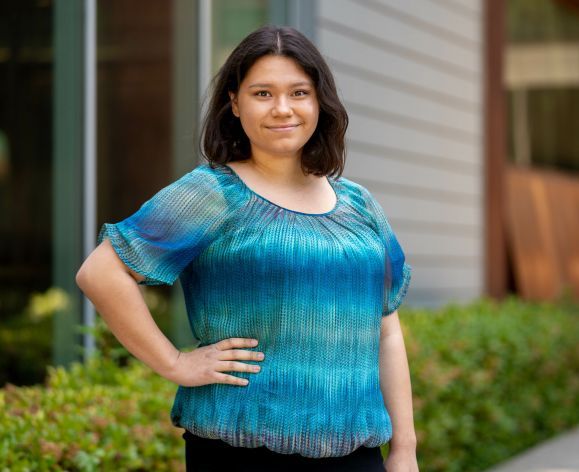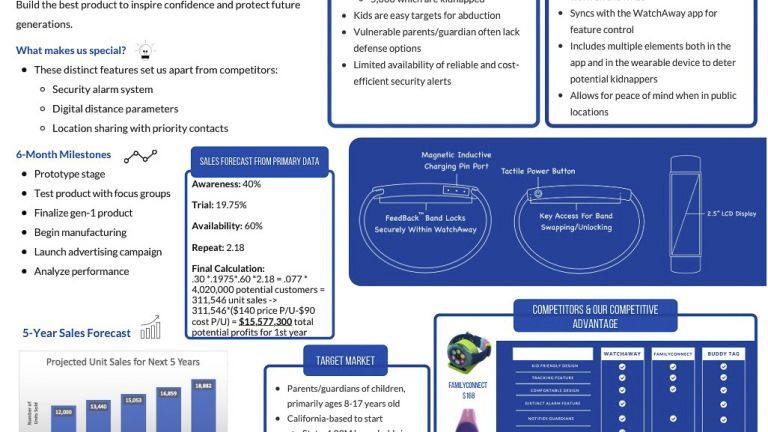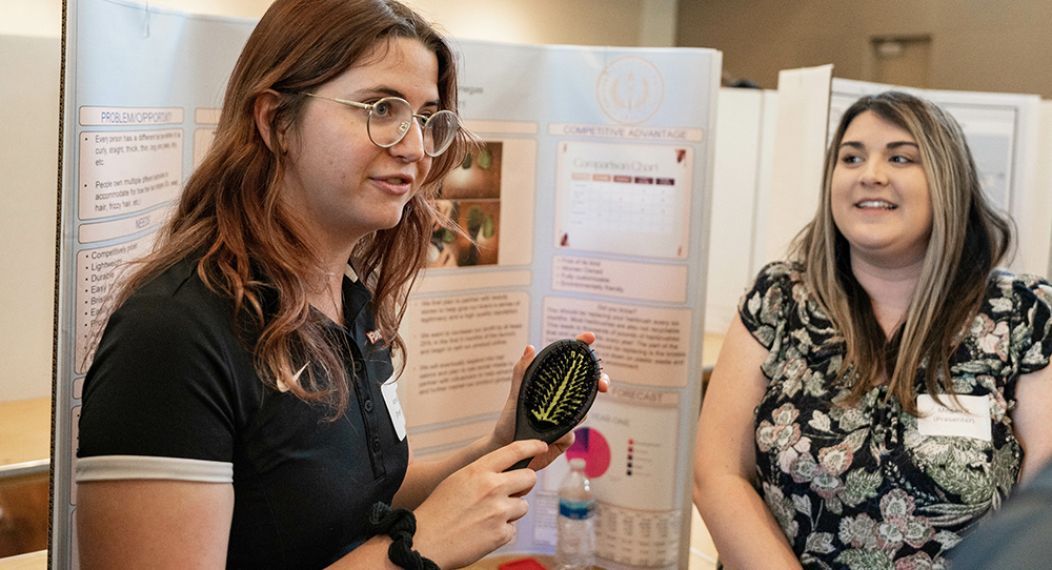The Pacific Innovation and Entrepreneurship Summit (PIES) is a gathering of Pacific students, faculty and alumni interested in innovation and entrepreneurship. The goal is to showcase the work of students, develop a collective community of Tigers interested in innovation and entrepreneurship and to discuss entrepreneurial ideas and opportunities for the future.
The 5th annual Pacific Innovation and Entrepreneurship Summit took place on April 18 at Pacific's DeRosa University Center. The event had three key segments which showcased students' entrepreneurial spirit and creativity, empowered future entrepreneurs and connected them with the local community:
- Tiger Tradeshow
- Pacific Pitch Competition
- Fantastic Forum
Pacific Pitch
Pacific Pitch is a shark-tank-style competition that will take place as part of the Pacific Innovation and Entrepreneurship Summit. Entrants will deliver a 5-minute pitch describing their new product, service, or business to a panel of experts, who will determine the winning teams.
Tiger Tradeshow
The Tiger Tradeshow is a marketplace of ideas where students showcase a new product, service, or business they are working on developing. This is a key networking opportunity that provides students with a non-competitive environment to share ideas and foster a community of innovation and entrepreneurship.
Fantastic Forum
The Fantastic Forum is a public panel discussion comprised of leading investors and entrepreneurs discussing emerging entrepreneurial needs and opportunities.

For Media X major April Chai ’22, Pacific Innovation and Entrepreneurship Summit (PIES) was a night of unbelievable success. Not only did she compete as a finalist in the Pacific Pitch competition with her horror film concept “The Monster in the Forest,” but she also won the first-place prize of $1,000.

WatchAway
WatchAway aims to build the best product to inspire confidence and protect future generations by creating an easy-to-use child protection device and app.

Hana Pot
A sustainable pot that grows with your plant, Hana Pot is a female-owned, California-based company that sells origami pots through their e-commerce website.
Pacific Pitch 2023
First place: The Magna Glove
School: Eberhardt School of Business
Students: Thomas O’Rourke, Nike Chen and Coby McCaig
Finalists:
- Refresh, a one-stop-shop grocery management application
Student: Vicky Guan ’23, bioengineering major - The(ta) Hair Necessities, a customizable hair brush with interchangeable bristle
Students: Amelia Nish ’23, engineering management; Megan Rayback ’23, civil engineering; and Kaitlyn Venegas ’24, engineering management - Khulja Sim Sim, a unique gifting experience
Student: Pranath Manoj Aacha '24, MSBA
Tiger Tradeshow 2023
First place: Amelia Nish ’23, engineering management; Megan Rayback ’23, civil engineering; and Kaitlyn Venegas ’24, engineering management, for The(ta) Hair Necessities, a customizable hairbrush with interchangeable bristles.
Second place: Kailey Espinoza ’23, engineering management, and Olivia Ong ’23, engineering management, for Greenie, a bin that uses artificial intelligence to automatically sort trash.
Third place: Alex Machuca ’23, engineering management, and Curtis Hsiao ’23, engineering management, for PawTinder, a platform where pet owners can schedule play dates and communicate with one another.
Third place: Jeyrik Paduga ’23, engineering management; Rita Kearns ’23, engineering management; and Lily Torpey ’23, engineering management, for SunBeets, eco-friendly stylish sunglasses promoting sustainable fashion by utilizing naturally harvested beetle-killed wood.
Who can enter?
Any individual team with a Pacific affiliation (student, staff, alumni, faculty, supporter) who submits the Pacific Pitch online entry form can enter the competition.
When and how to enter?
- April 1: Interested individuals and teams should send an email to entrepreneurship@PACIFIC.EDU no later than April 1.
What should the PowerPoint pitch slides include?
The pitch is a maximum of 5 minutes in length and should include the following:
- Name and Mission of the Company: Don’t leave the audience guessing. The first slide should clearly state the name and the mission of the company. The mission statement should be concise (1 or 2 sentences) and state what product or service you provide and for who.
- The Problem, Need or Opportunity: What is the problem, need or opportunity that your product, service, or business addresses? Who experiences the problem or need? What proof is there that the problem or need is significant for them? Providing a qualitative or quantitative data point (e.g. a quote or a statistic) can help the audience “get” the problem.
- The solution (product/service and value proposition): What is the product or service that will solve the problem? You should emphasize not only the features but the “value” it delivers in addressing the need identified above.
- How the solution works: A depiction, prototype or sample can be used to give the audience a more concrete sense of how the product or service would work. For example, showing a user interface for an app or a drawing, sketch or sample for a product will help viewers get a tangible sense of the solution.
- Competitive Advantage: What other products, services, or businesses are there in the market that try to solve the same problem or need, and what will give you a competitive advantage over them? This can be shown visually using a table that compares features across products.
- Market Size and Target Market: You should clearly express how big the overall market is (in terms of dollars), as well as the serviceable market that you can reach within five years. The serviceable market should be based on clear statement of (a) what segment of the overall market you are targeting and (b) what channels you are using to reach them.
- Go-to-Market Strategy: The go-to-market strategy slide should explain your beachhead market (i.e. where and to whom will you first reach out to begin selling to customers) and why it makes sense as the place for you to start. It should then explain where and how you plan to expand over the next five years. What is the sequence of markets you will enter, and how you plan to enter them (e.g. channels, partnerships, etc that you plan to use)?
- How will you make money (Per Unit Economics): Show how the product, service or business will make money by showing (a) what your price per customer or product will be, (b) what your variable costs (the costs that depend on the volume or products) will be and (c) what your fixed costs are (the costs that don’t vary depending on volume). This is typically best explained on a per-customer basis.
- Revenue Projections: This slide should project revenue (and customers) for the next five years, and should be linked to the logic of your go-to-market strategy.
- Need/Ask: You should clearly state what you need at this point in the development of the venture. Most teams state a need for some amount of capital but consider also expressing needs for key hires or co-founders (to build out the team), partners (to gain access to suppliers or customers), or advisors. The need should be specific to what you want to accomplish in the next 6 to 12 months.
- Milestones: The milestones make clear what you will accomplish over the next 6 to 12 months if you get the resources you’re asking for. This might include things like completing a prototype, launching the business, or striking key partnerships. You should also provide a timeline for milestones that will follow in the next 5 years.
- Thank you: Don’t forget to end the presentation so that the audience knows when you’re done! The easiest way to do this is to have a “Thank you” slide and to say those words, along with a sentence or two inviting interested parties to follow up with you and meet you afterward.
How to be successful in the Pacific Pitch
Keep in mind that in five minutes, you’re being judged in a number of different ways. Part of it is the logic and soundness of your product, service or business, and how well it has been thought out and researched. But that’s only part of it. Judges will also evaluate you based on:
- how understandable you are (you can’t win if they don’t “get” what you’re doing);
- how the visual aspects of the pitch support what you’re saying (visually clean and attractive slides that are not cluttered with too many words is crucial for their comprehension);
- how appealing you are as a potential partner to work with;
- the emotional tug and relevance of the concept (is this something the world really needs and is this team actually passionate about it). So keep all these aspects in mind as you prepare.
Who can enter?
Any individual team with a Pacific affiliation (student, staff, alumni, faculty, supporter) who submits the online form expressing their interest will be guaranteed a spot, as long as they are genuinely interested in participating and as long as there is space available.
Individuals and teams without a Pacific affiliation (e.g. students from other colleges and universities, members of the community, etc) are also welcome to submit the online form and will be considered on a competitive basis depending on space availability.
When and how to enter?
- April 1: Interested individuals and teams should send an email to entrepreneurship@PACIFIC.EDU no later than April 1.
What should the poster include?
The poster can include anything you want, but should the following information at a minimum:
- The Problem, Need or Opportunity: What is the problem, need or opportunity that your product, service, or business addresses? Who experiences the problem or need? What proof is there that the problem or need is significant for them?
- The solution (product/service and value proposition): What is the product or service that will solve the problem? You should emphasize not only the features but the “value” it delivers in addressing the customer’s need?
- How the solution works: A depiction, prototype or sample can be used to give the viewer a more concrete sense of how the product or service would work. For example, showing a user interface for an app or a drawing or prototype for a product will help viewers get a tangible sense of the solution.
- Competitive Advantage: What other products, services, or businesses are there in the market that try to solve the same problem or need, and what will give you a competitive advantage over them? This can be shown visually using a table that compares features across products.
- How will you make money (Per Unit Economics): Show how the product, service or business will make money by showing (a) what your price per customer or product will be, (b) what your variable costs (the costs that depend on the volume or products) will be and (c) what your fixed costs are (the costs that don’t vary depending on volume).
How to be successful in the Tradeshow:
Keep in mind that the Tradeshow will be a very social, hectic, and interactive environment. You will only have a few minutes to convince passersby of the value of your product, service, or business and get them to “invest” their coins in you. In this process, three things really matter:
- Having an interesting product, service or business and really knowing both your product and your customer well. An interesting product will be crucial for getting their attention but knowledge will be crucial to effectively answering the questions they have.
- Having good visual and physical aids. The poster and any other materials (prototypes, flyers, etc) should aid your engagement with attendees. They should be visually appealing and easy to understand but at the same time well thought through and credible. Remember that you’re are convincing them based not only on research and logic but also based on what they see and touch.
- Being engaging and interactive. Ultimately the ability to hold an effective conversation and sell yourself as well as your idea in a short period of time is crucial to success.






